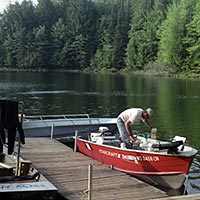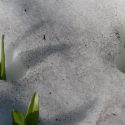Reservoirs promote spread of aquatic invasive species
The latest “damming” evidence suggests that manmade reservoirs are facilitating the spread of invasive species in Wisconsin lakes.
In a comparison of natural lakes and impoundments — reservoirs created by damming rivers — the impoundments were up to 300 times more likely than lakes to harbor invasive aquatic species, according to a study published last month in the journal Frontiers in Ecology and the Environment.

A new study shows that manmade reservoirs are up to 300 times more likely than natural lakes such as Crampton Lake in northern Wisconsin (pictured above) to harbor invasive species.
Jake Vander Zanden of UW–Madison, Pieter Johnson of the University of Colorado-Boulder and Julian Olden of the University of Washington looked at five increasingly common aquatic invasive species — Eurasian watermilfoil, spiny water flea, zebra mussel, rusty crayfish and rainbow smelt — in 1,081 lakes and impoundments in Wisconsin and Michigan’s Upper Peninsula.
The impoundments had greater risk of invasion by each of the five species, ranging from a modest two-fold risk increase of harboring watermilfoil or rusty crayfish to 300 times the risk of containing spiny water flea. Impoundments were also more likely than natural lakes to host multiple invasive species.
Invasive species can have profound ecological and economic impacts, including changing water quality, fouling boats and industrial equipment, and competing with or preying on native species. “Invasions are one of the major drivers of global change, one of the major ways we are changing the surface of this planet,” says Vander Zanden, a professor at the UW–Madison Center for Limnology.
The impoundments also appear to increase the invasion risk of natural lakes through what he calls a “stepping stone” effect — reservoirs’ favorable conditions give invasive species an entry point into the landscape from which they can more easily spread to nearby lakes.
“These impoundments bridge the gap so that it’s easier for an invasive to make the hop from one [natural] system to the next,” Vander Zanden says. For example, the spiny water flea was first discovered in inland Wisconsin in the Gile Flowage, a reservoir situated halfway between Lake Superior and the Northern Highlands Lake District. It has since spread to at least one natural lake in the region.
The new analysis links higher non-native invasion risk to high levels of human use, especially boating, and environmental conditions such as water body size and chemical properties. In addition, manmade reservoirs typically contain young, less established ecological communities that may allow invasive species to gain a foothold, says Johnson, a former UW–Madison scientist who is now an ecologist at UC-Boulder.
Much of the data used for the study came from resource management agencies, including the Wisconsin Department of Natural Resources and the Great Lakes Indian Fish and Wildlife Commission. The researchers hope that improving the understanding of invasion risk will help guide and prioritize management and eradication efforts.
“Targeted prevention and control efforts can give more bang for the buck,” Johnson says. “Impoundments may be a good target for those efforts.”
Subscribe to Wisconsin Ideas
Want more stories of the Wisconsin Idea in action? Sign-up for our monthly e-newsletter highlighting how Badgers are taking their education and research beyond the boundaries of the classroom to improve lives.



